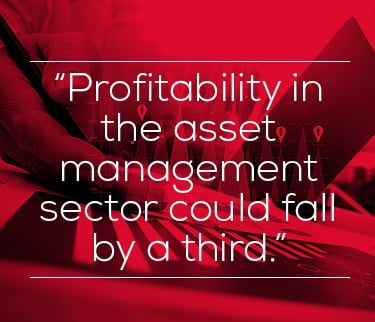Asset managers face unprecedented opportunities in today’s fast-moving marketplace. There are also a myriad of threats.
 On the one hand, the outlook for growth is strong. 89% of asset managers surveyed by State Street recently are looking forward to profitable growth and demand for new products, and services from investors is increasing.
On the one hand, the outlook for growth is strong. 89% of asset managers surveyed by State Street recently are looking forward to profitable growth and demand for new products, and services from investors is increasing.
But cost pressures are mounting, particularly given the burden of regulatory change and increased market activity. State Street’s research found 79% of asset managers now expect to face direct competition from new entrants to the sector from other industries.
Think Google, Facebook, and Amazon.
In order to walk the tightrope between opportunity and threat, asset managers will need to understand the themes most likely to drive value in their businesses over the years ahead – and to develop strategies for responding to them.
Bespoke demand
One crucial emerging theme, for example, is the demand from clients for more solutions built around their specific investment needs, rather than product lines. Investors are looking for better returns with lower fees and want investment solutions that are tailored to their individual objectives.
{{cta(‘bcdd0f82-15ab-4a31-97d7-953aaeb085d7’)}}
This will require their managers to provide multi-strategy investment portfolios, including traditional long-only equity and bond holdings, but also a range of other assets, such as ETFs, complex derivatives, alternative assets and hedge funds.
At the same time, however, clients are demanding greater transparency from their asset managers, even on multi-asset investment portfolios. In short, they want far more information about how their money is being invested, and why. This data, moreover, will be as much about risk management as asset allocation and performance.
More for less
Then there is the demand from clients for asset managers to supply their services more cost efficiently. One recent report from McKinsey warned that profitability in the asset management sector could fall by a third, such is the demand for low-cost products from investors, with flows of money into cheap passive funds already rising quickly, for example.
Nor are investors only concerned with cost. As a study from Deloitte points out, asset managers must be prepared for demographic shifts in which millennial investors account for an increasing proportion of their client base. These investors, who have grown up taking digital functionality for granted, will not accept the sort of customer experience asset managers have offered in the past.
How, then, to meet these challenges in order to capture growth? How do we service both the developed markets and client types where we have have traditionally devoted our energies and also in emerging economies and investors, to which wealth is gradually shifting?
Deloitte argues that the asset managers who succeed, whether on a global scale or in niche sectors and markets, will be those able to capture the “triumph of technology”. In other words, to pair emerging data and analytics applications with the traditional tools of the investment management sector in order to offer clients the analysis and reporting they’re looking for.
There is, however, a problem with this thesis. The reality of the asset management sector today is that many businesses lack the functionality they need in the middle office to strive towards such transparent and timely reporting ambitions. In particular, the performance measurement infrastructure of leading asset managers is often no longer fit for purpose. It may do a reasonable job of delivering fairly accurate and basic information, but it isn’t able to cope with more complicated asset mixes or the demand for daily performance data.
The result, complain specialists in performance and analytics, is that rather than focusing their attentions on value-added work that will deliver the enhanced propositions for which clients are now looking, middle office teams are preoccupied with manual processing tasks. It’s a waste of resources that threatens to undermine asset managers’ ability to capitalize on the changing dynamics of their market – and to leave them vulnerable to new entrants from other sectors who are not burdened by the same legacy technology issues.
That’s why now is the time for asset managers to think more strategically about the technology infrastructure powering their performance measurement operations.
Certainly, they need systems that do the basics exceptionally well: faster turnaround times, even for very large amounts of data; greater automation; enhanced accuracy and complete consistency.
But they also need additional functionality as they strive to take their businesses to the next step: better user interfaces to boost productivity and visibility; broader capabilities that deliver data on risk as well as performance; scalability so that the system will support the business as it grows; and accountability, through audit trails and governance processes.
It will also be important to future-proof this infrastructure. Cloud-based solutions, through which updates can be deployed quickly and frequently, will increasingly replace in-house IT and the resource-hungry cycle of software and hardware upgrades.
Asset managers that get the change process right will be well-placed to capitalize on the undoubted market opportunities that lie ahead. The danger for businesses that are slower to react, is a threat becoming reality.
Takeaways:
- Asset management is changing, with clients demanding better returns for smaller fees and looking for greater transparency
- Technology is the key for asset managers seeking to exploit new opportunities in the marketplace
- Too few asset managers currently have performance measurement tools that are fit for purpose in a world of growing data volumes
- Performance management tools need to do the basics better, but also offer greater functionality, more scalability and enhanced accountability
- Better performance measurement tools will provide asset managers with a powerful resource with which to build client engagement through superior analytics and reporting.
{{cta(‘fa3b4f0d-4c30-4f05-8a1f-f9f2febb3edb’)}}